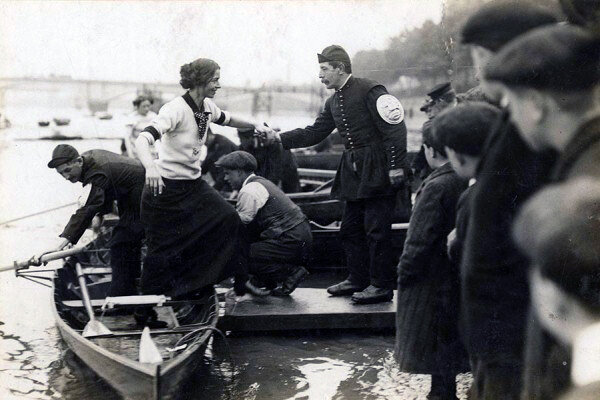Lucy Pocock: Not Just George’s Sister
Lucy Pocock, after winning the the first women’s event sponsored by Doggett’s Coat and Badge. (Photo courtesy of the River & Rowing Museum, Henley on Thames, Oxfordshire)
Born in 1891, George Pocock learned to scull at age 12, and won his first race when he was 15. He and his brother Dick learned how to build boats from their father – a boat builder at Eton College. In 1911 they moved to British Columbia, and within two years they were settled in Seattle, building boats for the crew at the University of Washington. Their story is long and impressive, and includes massive influence on boat building, collegiate rowing across the country, and the sport entire of rowing.
George got his start as a watermen in London. So did a lot of other men. Professional men who steered their wherries down rivers to deliver goods and people, and often took to racing each other for prize money. The Race for Doggett's Coat and Badge became a preeminent venue to show off their strength and stamina. In 1912, The Daily Mirror decided it was time for the women to get a chance, so the paper sponsored a race for female relatives of watermen who had previously competed in the event.
Richard Pocock had taken home the Coat and Badge in 1910, and it is reported that when Lucy stepped into her wherry on the Thames in 1912, so took to the water with dramatic style. She sculled well, though fell behind the leader, one Miss Brady by a half a length. But when Miss Brady caught an unfortunate crab 300 yards from the finish line, Lucy pulled ahead and won the race by less than half a boat length. Apparently she so exhausted herself that she collapsed into her boat at the finish line.
Lucy walked away the winner, pocketing a £10 prize which helped pay her way to the United States. In 1913 she joined her brothers George and Dick in Seattle, persuading the University of Washington to reinstate women's rowing and taking the position of women's rowing and swimming coach.
On January 15, 1914, the UW Daily described Lucy as “a fine example of what rowing can do for a woman, as she has been interested in this ever since she could lift an oar."
Though she only coached a single season, Lucy's partnership with other strong-willed women coaches – including Ethel Johnson and Helen Harrington – helped develop rowing into the most popular athletic activity for women on the UW campus, with 80 women rowing in the Fall of 1916.

